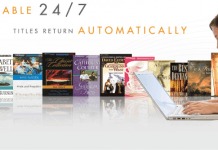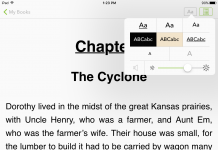
Libraries will lose out to profit-crazed publishers and other content-providers unless they can offer something back—beyond their current audiences. Penguin‘s refusal to provide new audiobooks to libraries is just part of an ugly pattern of bullying from the commercial side. Another, of course, is HarperCollins’ requirement that libraries loan an e-book no more than 26 times without paying for more reads.
How to respond? Earlier I proposed alibrary-friendly ecosystem for the creation, distribution, and popularization of e-books and other content of value to both the general public and specialists. I want library items for typical patrons to be as tempting and easy to download as anything from Amazon in the era of the Kindle Fire and similar machines. Mind you, national digital library systems should be extremely open to alliances with the commercial side and appreciate the risk-taking of publishers and others. But to regain lost bargaining power, libraries urgently need to establish their own ecosystem, not just rely on infrastructure and distribution controlled by for-profit corporations. May the day come when more publishers can cherish library-orignated content! Not to mention the possibility of revenue from library-linked stores and rental services. Otherwise the Shatzkin scenario, the death of public libraries, may eventually be reality.
Does this mean libraries should merely imitate Amazon or Google or those companies’ rivals? Certainly not, regardless of Amazon’s brilliant, seamless approach that makes e-books widely available in many different ways. With library values and ethics in mind, as well as new criteria related to usability and aesthetics, I’ll offer ten musts for a library ecosystem online. I’ll welcome suggestions for the “must” list. Also bear in mind that I have not prioritized all the items, even though “freedom” and “privacy” should come first.
1. Freedom to read what you want, in line with Richard Stallman’s thoughtsand many others’.
2. Privacy. In the 1990s, in an earlier library vision much refined since then, I called for e-book vending machine that accepted greenbacks and anonymous digital money. I take it for granted that Washington and power elites elsewhere will try to violate the privacy of library users, so we need alternatives. Richard, of course, has long held similar concerns.
3. Convenience, including the benefits of technical standards, so that works can be enjoyed on a variety of systems and are not tied to the standards of any one company. National digital library systems should not be in the hardware business in the fullest, most direct sense. But with potential collaborators such as the International Digital Publishing Forum, they should issue voluntary standards for software and hardware and help point users to products that would work smoothly with the library ecosystem—not just for text but also multimedia. National library systems could team up with collaborators such as One Laptop Per Child to develop reference designs that commercial vendors could adapt for their own purposes. The more hardware vendors involved, working on convenient-to-use hardware, the less easily the DRM interests can impose their will on the rest of the world.
Just as with the Kindle Fire, it should be simple for people to go back and forth from text items to multimedia (with optional restrictions available for special users, such as new readers whom the multimedia might distract) and find their original places, just as the Fire allows. That’s just one example. Convenience for the masses is no small requirement, the difference between a nice, tidy system for the techno- and cultural elites and one that ably serves the world at large. I believe that the confluence of elite and nonelite technologies and cultures can strengthen both kinds.
4. Permanence and repositionability of content, including the right to buy and own favorite library books and expect them to be accessible forever–in print or on paper–and able to be inherited by family members or friends. The current DRMed books are not permanent, because, especially within high-tech, companies and products come and go. Already Microsoft is phasing outits Microsoft Reader format.
Needless to say, like convenience, permanence is among the glories of nonproprietary standards. Permanence traditionally has been one of the traits of books, and DRM and the related “license only” philosophy are attacks on the medium as it has traditionally existed.
I also believe that books should not be remotely deletable except with the exp ress permission of buyers (for example, those interested in easy refunds on accidental purchases).
Of course, with library books, the system needs a means to enforce expiration. One way would be timed denial of access via the Web or via time-related caching limits (perhaps DRM by some definitions). But either a renewal or purchase should be able to quickly restore access.The caching approach would hardly be uncrackable. But then neither has been conventional e-book DRM.
5. The right of organizations and individuals to resell or loan owned e-books,just like the paper variety. One issue is whether this right would apply to books that were not remotely deletable, so “one at a time” is enforced.
Libraries would argue for rights to buy e-copies of books for an unlimited number of one-at-a-time accesses, in the paper tradition. Perhaps this won’t happen. But I’d love for the law to assure this.
If media conglomerates keep insisting on per-access-related compensation in place of the paper-book model, and if legislative cures are not likely, then one possible compromise might be a significant reduction in the lengths of copyright terms, at least as they affect libraries. No miracles expected, given the donations-related dominance of content-providers in Congress for the most part despite the impressive progress made against SOPA-PIPA. But libraries can at least try.
6. Other kinds of access, in all senses of the word–from the economic and geo kinds to to access for people with disabilities. Within “access,” I would also include linkability and the ability to be annotated (the latter is among the concerns of Sara Houghton in her E-Book Users Bill of Rights).
7. Pronounced diversity of content: different genres, political viewpoints, sufficient numbers of books by women and minorities. No quotas, please–just open-mindedness and lots and lots of loving support for literacy programs in minority communities, among others. The rediscovery of orphan works might be especially beneficial to minority writers neglected in the past.
The ecosystem should likewise include popular and academic books alike.
This is one reason why I personally favor two closely intertwined but separate systems, so that powerful, well-credentialed academics can’t prevail over the wishes of talented but obscure local and state librarians who know their audiences’ needs better. They could still share a common technical organization.
Also, just as Amazon’s ecosystem does, the library one should encompass multimedia and encourage the growth of a strong regional film industries, in addition to helping to fund national and international projects. I badly want text to be the main focus, especially since traditional, word-focus literacy is so often the path to mastery of others. But if this is to be a popular library, it could include nontexts and, if Hollywood and budgets allow, natural treasures such as the great films of the past.
8. Decentralization. Neither New York nor Washington should be able to tell the rest of the country what to read. Ties in with “diversity.” The ecosystem needs ways to identify the best books in different categories, but this should come from many sources.
9. General attention paid to usability and aesthetics. Without more usability, libraries will never be competitive against the commercial side. In fact, I regard aesthetics as part of usability, and the sales of both the Kindle and the iPad would seem to back me up.
Why are the interfaces of many library systems—online catalogs and other offerings—so jarringly ugly? Especially with budgets tight, I don’t expect libraries to compete overnight with Apple. But surely they can do better than today, especially if they forge alliances with academia and stay in close touch with arts departments. Geeks and art students should learn from each other and, when possible, create together. Steve Jobs could never have given us Macs, iPods, iPads, and the rest—from the sculpted-looking cases to the glorious fonts—if he hadn’t learned art fundamentals. To get close to home, the LibraryCity.org site is not a paragon, and I would welcome design help from the right people.
Advocates of free, unencumbered software have often given outrageously short shrift tp those traits. I can understand the reasons—the limited resources of volunteers, however brilliant and dedicated. But without convenience and aesthetics, the library world will tend to lose out to the commercial side. The reverse is that with those two traits, libraries in many cases might actually enjoy an advantage, for they need only focus on genuine services for users, as opposed to pushing commercial products and services. How many library users wouldn’t appreciate the absence of distracting ads for, say, home loans?
10. Fair compensation for creators of major formal works like books–based on access counts or otherwise. The “otherwise” would open up some new business models. The grants system and others within academia and the nonprofit world are not always appropriate for all kinds of books. I don’t want commercial trade publishers to go away; rather, to show more flexibility toward new models.
The library ecosystem will have to make compromises for the system to gain traction needed for bargaining power, but the above should be the ultimate goals.
Once the library system is robust enough, one strategy might be to pay content-providers less for DRM-linked works, which be eminently fair, given the subtraction of value for readers. An ultimate goal should be the death of DRM. I can’t tell you how much I hate the technology (not the people themselves). The damned DRM operation at Adobe wouldn’t even let me de-register some computers I’d sold! And even improved versions will undoubtedly come with their own obnoxious limitations.
What I have in mind is the sterile-insect strategy. Encourage the DRMers to mate within the library ecosystem, so to speak–make the system too important to be ignored. But as time goes by, use lower compensation for DRMed content and other means to nudge them to be open to a more reader-friendly approach. Hardware buyers should, as Richard Stallman has urged, have the option to order products without DRM.
Social DRM, such as inserting users’ names and addresses at the starts of books and perhaps elsewhere, comes with privacy risks. But it is not DRM in the strict sense and could be one intermediate step toward a DRMless world.
Those are my opinions, and I’ll try to show an open mind. I regard this post as a dialogue-starter rather than the final answer on everything covered here.
Details: The forest image is GNU-licensed and is from Eckhard Jacob. Also, the contact information in the linked item from 1994 is obsolete; these days I’m reachable at 703-370-6540 and davidrothman@pobox.com.
Update, 3:08 p.m., EST: Many publishers could also come out ahead if libraries had a good, robust ecosystem. More clout for libraries would mean more standard-setting assistance for publishers and less reliance on format-related bookstores that insist on more than their share of revenue. Apple’s new e-textbook format is the latest eBabel threat.
[Via LibraryCity]


































I would also suggest they lobby that a condition of copyright for e-books be that they are made available to the library system.